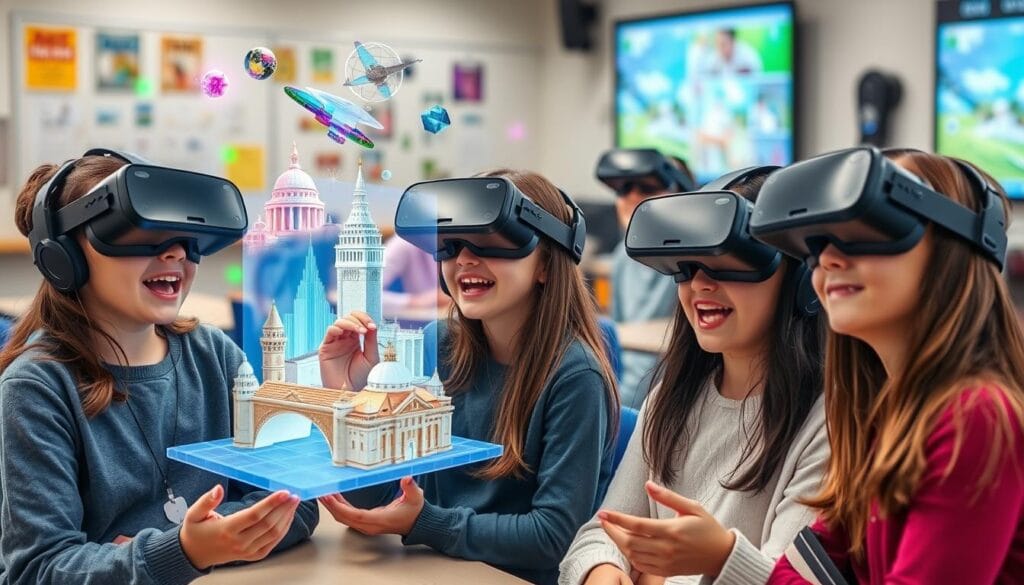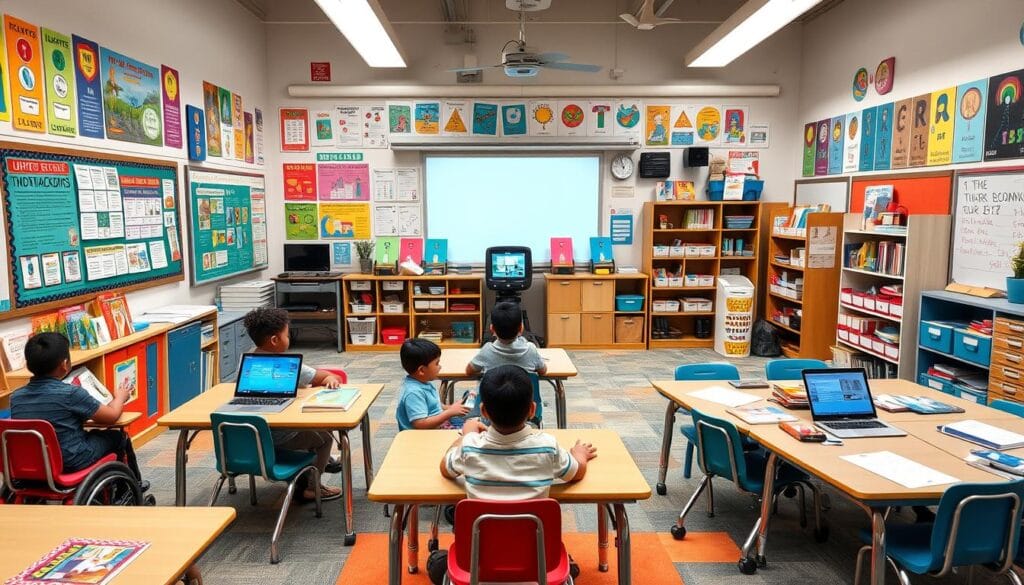Connectivism in Education: Definition, Principles, and Benefits
In today’s digital world, how we learn has changed a lot. The old way of learning is being replaced by something new called connectivism. This approach focuses on networks, technology, and information flow in learning and creating knowledge. It could change how we teach and learn, helping us deal with the fast pace of today’s world.
At the core of connectivism is the idea that learning happens through connections and interactions. With technology, learners can find lots of information, work with others, and explore on their own. This helps them understand things better and use what they learn in real life.
In this article, we’ll look at the main ideas of connectivism. We’ll see how it helps in schools and how it can change teaching and learning in our digital age.
فهرس المقالة
Understanding the Fundamentals of Connectivism in Education
Connectivism is a learning theory for today’s digital world. It has changed how we teach in the 21st century. Developed by George Siemens and Stephen Downes, it focuses on using technology to share and learn knowledge.
Origins and Development of Connectivism Theory
Connectivism came about because old learning theories couldn’t keep up with new tech. Siemens and Downes wanted a new way to learn in a world where info changes fast and connects everything.
Key Components of Digital Age Learning
At the heart of connectivism are networks and how info moves through them. Today’s learners build and use these networks to share and get knowledge. This way of learning is all about working together and learning from each other.
Role of Technology in Knowledge Distribution
Technology is key in connectivism for sharing knowledge. Tools like social media and online forums help learners find, organize, and share info worldwide. This makes learning more personal and connected, preparing students for today’s world.
By grasping connectivism’s basics, teachers can use tech to make learning fun and inclusive. This helps students get ready for the 21st century’s challenges.
The Evolution of Learning in the Digital Era
In the digital age, education has changed a lot. Old learning models are now replaced by new ones that use technology. This change makes learning more personal, collaborative, and flexible. Students now play a big role in learning.
Technology has opened up new ways to learn. We have virtual classrooms, online courses, and interactive platforms. This has made learning more accessible and flexible. Students can learn at their own pace and explore different interests.
Learning to use technology well is very important now. Students need to find reliable information and use technology wisely. Being able to adapt to new technology is key for success in today’s world.
“The real power of technology in education lies not in the devices themselves, but in the ways they enable new forms of learning, exploring, and collaborating.”
The digital age is changing education in big ways. Technology helps make learning more engaging and personal. It prepares students for the challenges of the 21st century.
| Traditional Learning | Digital Age Pedagogy |
|---|---|
| Passive, teacher-centered approach | Active, student-centered learning |
| Limited access to information | Abundant access to online resources |
| Standardized curriculum and assessments | Personalized, adaptive learning experiences |
| Rigid class schedules and structures | Flexible, self-paced learning opportunities |
| Isolated, individual learning | Collaborative, networked learning |
Core Principles of Networked Learning
In today’s digital world, networked learning is key for sharing and learning together. It shows that learning isn’t just in classrooms or alone. It’s about making and sharing knowledge in networks.
Network Formation and Knowledge Creation
Networked learning focuses on building networks. People and groups share ideas and skills. This way, new knowledge is made, changing how we learn.
Everyone in these networks helps create and share knowledge. This makes learning a team effort, where everyone feels involved.
Information Flow in Connected Networks
Information moving through networks is vital in networked learning. Learners use digital tools to find and organize information. This helps them understand better.
Digital networks make it easy to share and check information. Learners can get and use information from many places at once.
Decision-Making in Complex Systems
Learning in networks means making smart choices. Learners deal with lots of information and connections. They must decide wisely based on what they know.
This skill is key for navigating complex learning environments. It helps learners become independent and quick to learn new things.
By following networked learning’s core ideas, schools and teachers can create better learning spaces. These spaces use digital tools to help learners succeed in today’s world.
Technology Integration in Connectivist Learning

In today’s digital world, technology is key in education, changing how we learn. It’s especially important for personalized learning networks. Many technologies help make connectivism work.
Social media like Twitter, LinkedIn, and forums help learners meet others. They share knowledge, solve problems together, and exchange ideas. This is at the heart of connectivist learning.
Learning management systems (LMS) are central for organizing learning. They let learners access materials, join discussions, and see their progress. This helps learners take charge of their learning.
Tools like Google Docs, Trello, and Slack make it easy to work together. They help learners share ideas and grow knowledge together. This makes learning a team effort.
Using these tools, teachers can create learning spaces that are engaging and interactive. These spaces encourage learners to think for themselves and solve problems. They also help learners explore different views and develop critical thinking.

“The role of technology in connectivist learning is to enable the creation and navigation of personalized learning networks, empowering learners to explore, connect, and contribute to the collective knowledge.”
As education keeps changing, using technology like connectivism is vital. It prepares learners for today’s world.
Social Learning Aspects of Connectivism
Connectivism is a learning theory for today’s digital world. It focuses on how we learn and share knowledge together. It promotes collaborative learning environments where learners share and build on each other’s ideas.
This approach helps learners become part of a community. Together, they create and spread knowledge through connected learning networks.
Building Collaborative Learning Communities
Connectivist learning models focus on building learning communities. Learners work together, sharing knowledge on digital platforms. This helps them feel connected and builds a sense of community.
Through these communities, learners can share different views. This leads to the growth of collective intelligence.
Peer-to-Peer Knowledge Exchange
Peer-to-Peer knowledge exchange is key in connectivism. Learners share their knowledge and experiences with each other. This creates a learning environment where everyone benefits.
By working together, learners build knowledge. They have discussions, debates, and create new ideas together.
Role of Social Media in Connected Learning
Social media has changed how we learn and share knowledge. Connectivist principles use social media for informal learning. It helps spread knowledge quickly and builds social learning networks.
By using social media, connectivism taps into a global community. It brings together diverse perspectives and collective intelligence.
Connectivism highlights the value of teamwork, sharing, and using digital tools in learning. It creates engaging and dynamic learning spaces. Educators can use these ideas to help learners succeed in today’s digital world.
Designing Effective Connected Learning Environments

In today’s digital world, making collaborative learning environments that use technology well is key. To make great connected learning environments, teachers need to follow some important rules and plans.
First, building a community and social engagement in the learning space is vital. By encouraging peer-to-peer knowledge exchange and teamwork, students can get a deeper grasp of the material. This also makes their personalized learning experiences better.
Using technology-enabled education tools like forums, video calls, and interactive digital stuff helps a lot. These tools make talking in real-time easier, let people share things, and get everyone involved in learning.
| Strategies for Effective Connected Learning Environments | Benefits |
|---|---|
| Fostering a sense of community and social engagement | Promotes peer-to-peer knowledge exchange and personalized learning |
| Incorporating technology-enabled education tools | Facilitates real-time communication, resource sharing, and active participation |
| Encouraging self-directed learning and personal learning networks | Empowers learners to take ownership of their educational journey |
Another important thing is to support self-directed learning and personal learning networks (PLNs). This lets learners control their learning path. They can dive into what interests them, improve their digital skills, and work with others to make learning fun and meaningful.
The main aim of creating effective connected learning environments is to build a lively, technology-enabled education space. This space should support collaborative learning and personalized learning networks. By using these methods, teachers can make learning fun and impactful for students in our digital age.
Self-Directed Learning in Connected Networks

In today’s digital world, students can learn in new ways. They use personalized learning networks (PLNs) to shape their own learning paths. This makes them key players in creating new knowledge.
Personal Learning Networks (PLNs)
A personal learning network is like a web of people, resources, and experts. It lets students tailor their learning to fit their needs. Through PLNs, they can find lots of information, work together, and make real connections in their digital age pedagogy.
Student Autonomy and Agency
Connectivism supports self-directed learning. It lets students control their learning, set their own goals, and explore the vast world of information. This freedom makes them active in building their knowledge and skills.
Digital Literacy Skills Development
Learning in the digital age needs strong digital skills. Students must learn to find, judge, and use information from many places. They also need to work well together and share ideas online. These skills are key for success in our changing world.
| Characteristic | Description |
|---|---|
| Personalized Learning Networks (PLNs) | Customizable, interconnected web of resources and experts that enable learners to curate their educational journey. |
| Student Autonomy and Agency | Learners take ownership of their learning, set personalized goals, and actively participate in knowledge construction. |
| Digital Literacy Skills | Ability to effectively search, evaluate, and synthesize information from diverse sources, as well as collaborate and communicate within online communities. |
“In a world of constant change, the ability to learn, unlearn, and relearn is one of the most important skills a person can have.”
Challenges and Criticisms of Connectivism
Connectivism in education is a promising idea for today’s digital world. Yet, it faces challenges and criticisms. One big issue is information overload. With so much data online, it’s hard for students and teachers to find and use the right information.
The digital divide is another problem. Some people don’t have the tech or skills to join in. This makes learning unfair and highlights the need for better access and support.
Some critics worry that connectivism might not help students learn deeply. They think the focus on connections and flow might ignore the importance of critical thinking. This skill is key for learning well in our digital age.
FAQ
What is connectivism and how does it apply to modern education?
Connectivism is a learning theory that values technology and networks in today’s world. It shows how learning happens through connections and knowledge sharing online. It’s key in modern education because it helps us adapt to new tech and focus on self-learning and teamwork.
What are the key principles of connectivism in education?
Connectivism’s main ideas include building networks, sharing information, and making decisions in complex systems. It’s about creating learning networks, exchanging info, and helping students make smart choices in tech-rich environments.
How does technology enable connectivist learning?
Tech is vital for connectivist learning. Tools like social media and learning systems help build personal learning networks. They support sharing knowledge and self-directed learning. This tech helps create dynamic learning spaces that follow connectivism’s principles.
What are the social learning aspects of connectivism?
Connectivism highlights the role of social learning. It focuses on learning together and sharing knowledge. Through digital tools, learners can discuss, share, and build knowledge together. This builds community and improves digital skills.
How can educators design effective connected learning environments?
To create great connected learning spaces, focus on engagement, teamwork, and personalized learning. Use tech to make learning interactive, support group projects, and let students choose their learning paths. This approach makes learning dynamic and meets students’ unique needs.
What is the role of self-directed learning in connectivist frameworks?
Connectivism values self-directed learning, where students manage their own learning. This includes building personal learning networks to access various information sources. By developing digital skills and taking charge of their learning, students become more engaged and adaptable.
What are some of the challenges and criticisms associated with connectivism in education?
Connectivism has its benefits but also faces challenges. Issues include information overload, digital divides, and the need for critical thinking. Educators must guide, teach digital literacy, and ensure fair access to tech in learning.






